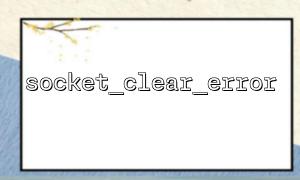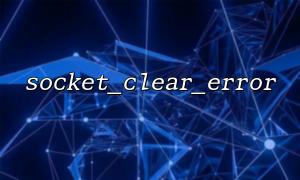When handling socket connections in PHP, developers often encounter various network exceptions and errors. PHP provides the socket_clear_error() function, which is used to clear the error status on the socket connection, and attempts to make the program "reset" the error, so as to continue execution. However, many times we will find that calling this function cannot really solve the fundamental problems of the socket itself. This article will analyze the reasons in detail and illustrate the correct handling ideas through examples.
socket_clear_error() is mainly used to clear the error flag of the current socket. Its function is equivalent to telling PHP: "The previous errors on this socket are temporarily ignored, I will continue to use it." But it does not fix network-level problems, connection interruptions or data transmission failures.
Let's give a simple example:
<?php
$socket = socket_create(AF_INET, SOCK_STREAM, SOL_TCP);
socket_connect($socket, "m66.net", 80);
// Suppose an error occurred here
$error = socket_last_error($socket);
echo "Error code:$error\n";
// Clear error
socket_clear_error($socket);
// Check for error again,Cleared
$errorAfterClear = socket_last_error($socket);
echo "清除后Error code:$errorAfterClear\n";
?>
The above code just clears the error status code, but socket_clear_error() cannot automatically fix these problems if the underlying network connection is disconnected or there are other exceptions.
The network connection itself may have expired <br> Network disconnection, remote server shutdown, router failure, etc. These problems are problems at the physical and protocol levels. Error flags simply reflect these problems and do not eliminate them. Clearing the error code just tells the program at the application layer that "the error is ignored", but the connection itself is still in an abnormal state.
Data transmission status has not been restored <br> If the socket is in a semi-closed state or there are residual errors in the data buffer, a simple clear error will not restore the data flow to normal. You still need to re-establish the connection or perform the corresponding error handling.
Program logic error not resolved <br> Many socket errors are caused by program logic, such as failure to properly close old connections, frequent connection disconnection and reconnection, or defective protocol implementation. socket_clear_error() cannot fix the program's design defects.
Detect errors and handle them appropriately <br> When an error is found, the error code should be read and the next step should be determined based on the type. For example, after the connection is disconnected, the socket should be closed and the connection should be re-established.
Avoid relying solely on socket_clear_error()
This function can be used to clean up error flags and avoid repeated processing of the same error, but it cannot be used as a means to restore the connection.
Design a robust reconnect mechanism <br> When the connection is abnormal, release the resources reasonably and wait for the right time to retry the connection to avoid frequent failures and causing resource exhaustion.
Logs and monitoring <br> Record the specific situation of socket errors, which facilitates troubleshooting and improvement.













